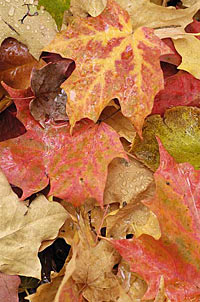Curiosities: Why do leaves change color in the fall?

Photo: Jeff Miller
Many of the colors we see in fall are always present, but normally they’re hidden from view, says UW-Madison Arboretum native plant gardener Susan Carpenter.
The leaves of trees and other plants contain three main pigments: carotene, anthocyanin, and the photosynthetic pigment, chlorophyll, which captures the sun’s energy to make food for plants. As the most abundant pigment, chlorophyll is what gives leaves their green hue in spring and summer.
Another chemical in leaves, auxin, controls a special band of cells at the base of each leaf stem, called the abscission layer. During the growing season, auxin prevents this layer from fully developing and blocking the tiny, internal tubes that connect each leaf to the rest of the tree’s circulatory system.
In fall, however, cooler and shorter days trigger an end to auxin production, allowing the abscission layer to grow and cut off the circulation of water, nutrients and sugar to the leaves. When this happens, chlorophyll disintegrates rapidly, letting carotene shine through as the yellow in maple, aspen and birch leaves. Anthocyanin, meanwhile, provides the oranges and reds of maples, sumacs and oaks. When there’s less sun, anthocyanin isn’t as chemically active and leaves are more orange or yellow than red.
Those interested in learning more are invited to an Arboretum family walk — “Why do leaves change color?” — on Sunday, Oct. 14, 1:30-2:30 p.m., starting at the Arboretum Visitor Center.
Tags: curiosities




